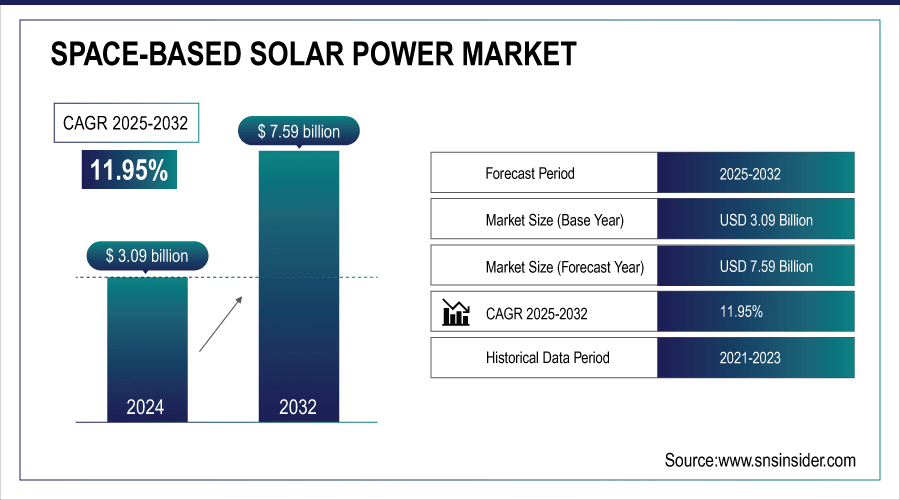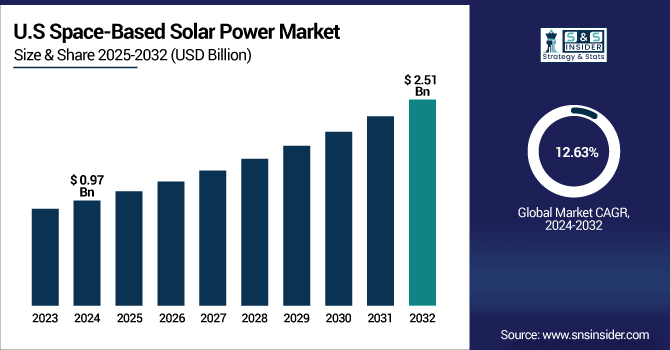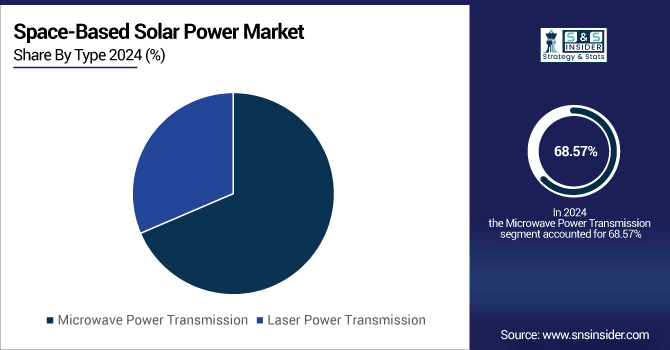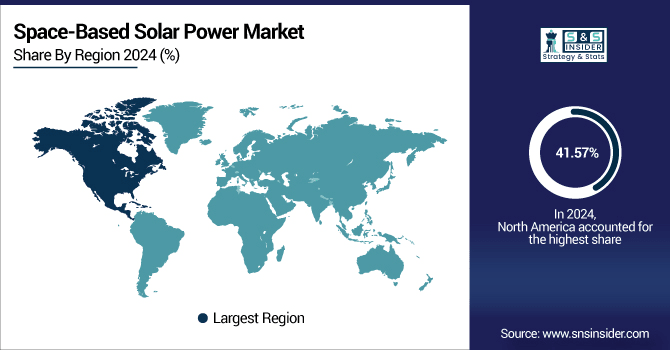Space-Based Solar Power Market Report Scope & Overview:
The Space-Based Solar Power Market size was valued at USD 3.09 Billion in 2024 and is projected to reach USD 7.59 Billion by 2032, growing at a CAGR of 11.95% during 2025-2032.
The Space-Based Solar Power (SBSP) market is growing due to rising global energy demand, the need for continuous and renewable power, and technological advancements in satellite-based solar energy collection and transmission. Government and private investments, environmental sustainability initiatives, and increasing focus on space exploration and infrastructure are driving adoption, while innovations in microwave and laser power transmission enhance efficiency and feasibility.
In 2024, Caltech's Space Solar Power Project (SSPP) achieved a significant milestone with its Space Solar Power Demonstrator (SSPD-1), featuring the Microwave Array for Power-transfer Low-orbit Experiment (MAPLE) technology. This innovation showcased the feasibility of wireless power transmission in space, a crucial step for SBSP's future.

To Get More Information On Space-Based Solar Power Market - Request Free Sample Report
Key Space-Based Solar Power Market Trends
-
Rapid adoption of satellite-based solar energy collection technologies for efficient space-to-Earth power transfer.
-
Increasing government and defense initiatives in the U.S., Japan, and Europe to support SBSP development.
-
Growing private-sector investments and commercialization of space solar power through satellite constellations.
-
Expansion of SBSP applications to remote areas, offshore platforms, and space exploration missions.
-
Strengthened collaborations between aerospace companies, research institutions, and governments driving technological innovation and global deployment.
The U.S. Space-Based Solar Power Market size was valued at USD 0.97 Billion in 2024 and is projected to reach USD 2.51 Billion by 2032, growing at a CAGR of 12.63% during 2025-2032. The U.S. space-based solar power market is expanding due to advancements in satellite technology, increased government support, and growing demand for renewable energy solutions. Initiatives like NASA's Space Solar Power Project and private ventures such as Aetherflux are driving innovation. Additionally, favorable policies and investments in clean energy infrastructure are contributing to this growth.

Space-Based Solar Power Market Growth Drivers:
-
Rising Global Energy Demand and Advanced Technologies Propel Continuous Renewable Growth in Space-Based Solar Power Market
The global Space-Based Solar Power market is primarily driven by the escalating demand for continuous, renewable, and clean energy solutions worldwide. Technological advancements in satellite-based solar energy collection, microwave and laser power transmission, and energy conversion systems are enabling more efficient space-to-Earth power transfer. Government initiatives and defense programs in countries like the U.S., Japan, and Europe are further propelling market growth. Rising concerns over carbon emissions and the need for sustainable energy alternatives are also encouraging adoption of SBSP systems.
UK-based company Space Solar, supported by over EURO 10 million in government grants, is advancing the concept of a solar power station in Earth's orbit, leveraging autonomous robots to assemble the structure.
Space-Based Solar Power Market Restraints:
-
Regulatory Challenges and Technical Complexities Restrict Rapid Adoption and Expansion of Space-Based Solar Power Market
The Space-Based Solar Power Market faces restraints from strict regulatory compliance and certification requirements, which can delay product approvals and limit rapid adoption. Additionally, complex installation processes and the need for highly skilled technicians in specialized aircraft systems may hinder widespread deployment. Variability in material availability and long lead times for high-performance alloys also pose operational challenges.
Space-Based Solar Power Market Opportunities:
-
Commercialization and Emerging Applications Drive Global Space-Based Solar Power Market Growth and Technological Innovation
Opportunities in the market include the commercialization of space solar power through private-sector investments and satellite constellations. Emerging applications, such as powering remote areas, offshore platforms, and space exploration missions, offer significant growth potential. Collaborations between aerospace companies, research institutions, and governments can accelerate technological innovation and expand SBSP deployment globally.
Space Solar plans to create a EURO 600 million system capable of transmitting renewable energy from orbit by 2029, with the initial "Merlin" system aiming to power about 45,000 homes.
Space-Based Solar Power Market Segment Analysis
-
By Type, Microwave Power Transmission dominated the market with a 68.57% share in 2024 and is expected to grow at the fastest CAGR of 11.56%.
-
By Component, Solar Collectors dominated the market with a 38.64% share, while Power Conversion Units are expected to grow at the fastest CAGR of 12.54% from 2025 to 2032.
-
By Application, Electricity Generation (Terrestrial) dominated the market with a 63.78% share and is expected to grow at the fastest CAGR of 12.29% from 2025 to 2032.
-
By End User, Government & Defense dominated the market with a 54.83% share, while Commercial & Private Companies are expected to grow at a CAGR of 12.28%.
By Type, Microwave Power Transmission Leads Space-Based Solar Power Market Driving Fast Growth Through Advanced Efficient Technology
Microwave Power Transmission dominated the Space-Based Solar Power market in 2024 due to its technological maturity, higher efficiency, and lower atmospheric interference compared to laser transmission. Advancements in microwave energy conversion and transmission systems are driving adoption, and it is expected to grow at the fastest CAGR from 2025 to 2032, fueled by increasing government and private sector investments worldwide.

By Component, Solar Collectors Lead Space-Based Solar Power Market While Power Conversion Units Drive Future Rapid Growth
Solar Collectors dominated the Space-Based Solar Power market due to their high efficiency in capturing solar energy and technological advancements in photovoltaic and thermal collection systems. They remain the primary choice for large-scale orbital energy harvesting. Meanwhile, Power Conversion Units are expected to grow at the fastest CAGR from 2025 to 2032, driven by innovations in efficient energy conversion technologies, which enable effective transformation and transmission of collected solar power to Earth, supporting the expanding global demand for renewable energy solutions.
By Application, Terrestrial Electricity Generation Leading Space-Based Solar Power Market with Continuous Reliable and Sustainable Energy Solutions
Electricity Generation (Terrestrial) dominated the Space-Based Solar Power market due to its ability to provide continuous, reliable, and renewable energy to meet growing global demand. Its adoption is driven by government initiatives, technological advancements in satellite solar energy collection, and increasing focus on sustainability. The segment is expected to grow at the fastest CAGR from 2025 to 2032, fueled by expanding infrastructure and investments in space-to-Earth energy transmission systems.
By End User, Government and Private Sector Driving Rapid Growth in the Space-Based Solar Power Market Worldwide
Government & Defense dominated the Space-Based Solar Power market due to extensive investments in energy security, strategic applications, and continuous power supply for space and remote operations. Meanwhile, Commercial & Private Companies are expected to experience the fastest-growing CAGR, driven by increasing private-sector investments, commercialization of satellite solar power projects, and innovative applications for remote energy supply, offshore platforms, and infrastructure, supporting the global transition to renewable and sustainable energy solutions.
Space-Based Solar Power Market Report Analysis
North America Space-Based Solar Power Market Insights
North America dominated the Space-Based Solar Power market with a 41.57% share in 2024, driven by strong government initiatives, advanced space infrastructure, and technological leadership. The region is expected to grow at the fastest CAGR of 12.37% from 2025 to 2032, supported by increasing investments from both governmental and private entities in satellite solar energy projects and renewable energy innovations.

Get Customized Report as Per Your Business Requirement - Enquiry Now
U.S. America Space-Based Solar Power Market Insights
The U.S. dominated the North American SBSP market, fueled by NASA’s Space Solar Power Project, defense programs, and significant private-sector investments in satellite-based solar energy and renewable infrastructure.
Asia Pacific Space-Based Solar Power Market Insights
The Asia Pacific Space-Based Solar Power market held a 21.28% share in 2024, driven by increasing investments in space technology, renewable energy initiatives, and collaborations between government agencies and private enterprises. Rapid industrialization, growing energy demand, and technological advancements in satellite solar energy collection are supporting market growth. The region is witnessing rising interest in space-based renewable solutions to enhance energy security and sustainability across emerging economies.
China Space-Based Solar Power Market Insights
China dominated the Asia Pacific SBSP market, leveraging the China Aerospace Science and Technology Corporation (CASC) and national space programs to advance satellite solar power technology and large-scale renewable energy initiatives.
Europe Space-Based Solar Power Market Insights
The Europe Space-Based Solar Power market is expanding due to strong government support, technological advancements, and initiatives like the European Space Agency’s Solaris program. The focus on renewable energy, reducing carbon emissions, and enhancing energy security is driving adoption. Collaborative projects between aerospace companies and research institutions are advancing satellite solar energy collection and transmission technologies. Europe is also exploring innovative applications, including supplying continuous clean energy to remote locations and supporting future space exploration missions.
Germany Space-Based Solar Power Market Insights
Germany dominated the European SBSP market, supported by its advanced aerospace industry, investments in renewable energy technology, and active participation in ESA projects for space-based solar energy development.
Latin America (LATAM) and Middle East & Africa (MEA) Space-Based Solar Power Market Insights
The Latin America (LATAM) and Middle East & Africa (MEA) Space-Based Solar Power markets are emerging regions with growing interest in renewable energy solutions. Market growth is driven by increasing government initiatives, investments in space technology, and the need for reliable power in remote and off-grid areas. Both regions are exploring collaborations with global aerospace companies to develop satellite solar energy projects and advance infrastructure for sustainable energy generation.
Competitive Landscape for Space-Based Solar Power Market:
The China Aerospace Science and Technology Corporation (CASC) is a state-owned enterprise leading China’s effort in space-based solar power (SBSP). CASC is developing a 1-kilometer-wide solar array in space, aiming to collect energy more than 10 times more efficiently than terrestrial photovoltaic panels. This energy will be converted into microwaves and transmitted to Earth, potentially providing a continuous and renewable energy source
-
In January 2025, Chinese scientists announced plans to construct a 1-kilometer-wide solar power station in space. This ambitious project aims to beam continuous energy back to Earth via microwaves, potentially collecting more energy in a year than all the oil on Earth
The Air Force Research Laboratory (AFRL) is advancing space-based solar power through its Space Solar Power Incremental Demonstrations and Research (SSPIDR) project. This initiative aims to develop technologies for capturing solar energy in space, converting it into radio frequency (RF) energy, and beaming it to Earth. The Arachne experiment, a key component of SSPIDR, will demonstrate the collection, conversion, and transmission of solar energy using innovative "sandwich tiles".
-
In November 2024, the AFRL launched the Space Power InfraRed Regulation and Analysis of Lifetime (SPIRRAL) experiment aboard the SPX-31 mission
Space-Based Solar Power Market Key Players:
Some of the Space-Based Solar Power Market Companies
-
China Aerospace Science and Technology Corporation (CASC)
-
Air Force Research Laboratory (AFRL)
-
Northrop Grumman Corporation
-
Japan Aerospace Exploration Agency (JAXA)
-
Solaren Corporation
-
Azur Space Solar Power GmbH
-
SolAero Technologies Corporation
-
Rostec Corporation
-
SpaceTech GmbH
-
Frazer-Nash Consultancy
-
Airbus
-
OHB SE
-
Thales Alenia Space
-
Boeing
-
Celestia Energy
-
Emrod
-
EnergySpace
-
Entropy Research and Development
-
Fibertek
-
Aetherflux
| Report Attributes | Details |
|---|---|
| Market Size in 2024 | USD 3.09 Billion |
| Market Size by 2032 | USD 7.59 Billion |
| CAGR | CAGR of 11.95% From 2025 to 2032 |
| Base Year | 2024 |
| Forecast Period | 2025-2032 |
| Historical Data | 2021-2023 |
| Report Scope & Coverage | Market Size, Segments Analysis, Competitive Landscape, Regional Analysis, DROC & SWOT Analysis, Forecast Outlook |
| Key Segments | • By Type (Microwave Power Transmission, and Laser Power Transmission) • By Component (Solar Collectors, Power Conversion Units, Transmission Systems, and Control & Management Systems) • By Application (Electricity Generation (Terrestrial), and Space Applications (Satellites, Lunar Bases)) • By End User (Government & Defense, and Commercial & Private Companies) |
| Regional Analysis/Coverage | North America (US, Canada, Mexico), Europe (Germany, France, UK, Italy, Spain, Poland, Turkey, Rest of Europe), Asia Pacific (China, India, Japan, South Korea, Singapore, Australia, Taiwan, Rest of Asia Pacific), Middle East & Africa (UAE, Saudi Arabia, Qatar, South Africa, Rest of Middle East & Africa), Latin America (Brazil, Argentina, Rest of Latin America) |
| Company Profiles | China Aerospace Science and Technology Corporation (CASC), Air Force Research Laboratory (AFRL), Northrop Grumman Corporation, Japan Aerospace Exploration Agency (JAXA), Solaren Corporation, Azur Space Solar Power GmbH, SolAero Technologies Corporation, Rostec Corporation, SpaceTech GmbH, Frazer-Nash Consultancy, Airbus, OHB SE, Thales Alenia Space, Boeing, Celestia Energy, Emrod, EnergySpace, Entropy Research and Development, Fibertek, Aetherflux |

